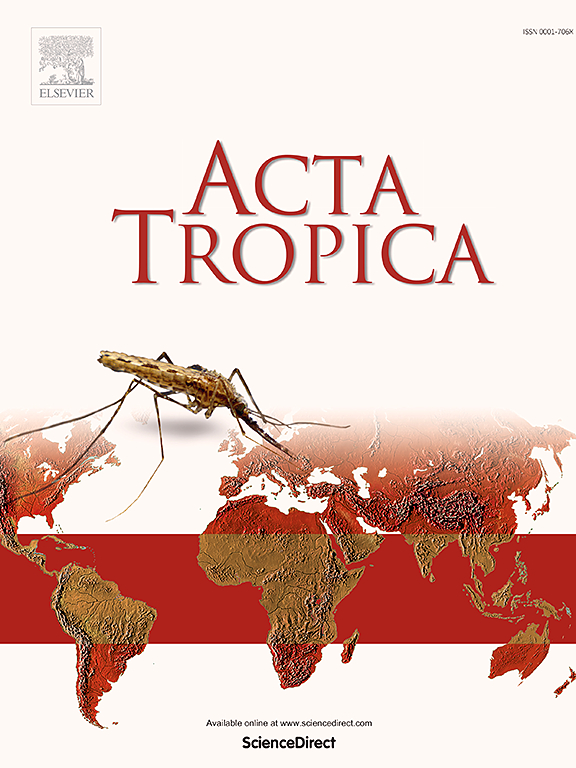Heterorhabditis indica and Steinernema siamkayai in central Thailand and their potential for controlling Aedes aegypti larvae in artificial container-breeding site
IF 2.1
3区 医学
Q2 PARASITOLOGY
引用次数: 0
Abstract
Entomopathogenic nematodes (EPNs) have been extensively researched as biocontrol agents because of their effectiveness against various insect pests, including Aedes aegypti larvae, which are significant vectors of several serious diseases. While the efficacy of EPNs in killing mosquito larvae has been evaluated in laboratory settings, there are limited studies focusing on mosquito breeding containers. This study aims to isolate and identify EPN species in central Thailand and assess their effectiveness against Ae. aegypti larvae in artificial breeding sites. Forty-two isolates of EPNs were molecularly identified, revealing a close relationship to S. siamkayai and H. indica. Most EPNs were isolated from loam soils with temperatures ranging from 28–35 °C, a pH between 3.0–7.0, and soil moisture content of 1–8 %. The distribution of EPNs was linked to moisture content. All selected EPN isolates demonstrated significant mortality of Ae. aegypti larvae compared to the control, with H. indica (eCAT3.5_TH and eCNW14.5_TH) showing slightly higher efficacy than S. siamkayai (eCKP34.1_TH). The type of artificial-breeding container and water height did not significantly affect larval mortality. The highest mortality rates were recorded in ant traps, followed by vases and plastic pots. Additionally, both male and female adult EPNs were observed in larval cadavers. While melanized EPNs were found in both larval and pupal cadavers. The EPNs can grow and complete their life cycles, indicating their sustainability and efficacy for mosquito management by reducing adult emergence.

泰国中部地区的籼稻异虫和暹卡伊斯坦虫及其在人工容器孳生地控制埃及伊蚊幼虫的潜力
昆虫病原线虫(EPNs)作为一种生物防治剂被广泛研究,因为它们对多种害虫具有有效的防治作用,其中包括埃及伊蚊幼虫,它是几种严重疾病的重要媒介。虽然EPNs杀灭蚊子幼虫的功效已经在实验室环境中进行了评估,但针对蚊子繁殖容器的研究有限。本研究旨在对泰国中部地区的EPN进行分离鉴定,并评价其对伊蚊的防治效果。人工繁殖地的埃及伊蚊幼虫。结果表明,42株epn与siamkayai和H. indica亲缘关系较近。大多数epn是从温度为28-35°C、pH值为3.0-7.0、土壤含水量为1 - 8%的壤土中分离出来的。epn的分布与水分有关。所有选择的EPN分离株均表现出显著的伊蚊死亡率。与对照相比,印度伊蚊(eCAT3.5_TH和eCNW14.5_TH)的效果略高于暹罗伊蚊(eCKP34.1_TH)。人工养殖容器类型和水面高度对幼虫死亡率影响不显著。蚂蚁陷阱的死亡率最高,其次是花瓶和塑料盆。此外,在幼虫尸体中还观察到雄性和雌性成年epn。而在幼虫和蛹尸体中均发现了黑化的epn。epn可以生长并完成其生命周期,表明其可持续性和通过减少成虫羽化来管理蚊子的有效性。
本文章由计算机程序翻译,如有差异,请以英文原文为准。
求助全文
约1分钟内获得全文
求助全文
来源期刊

Acta tropica
医学-寄生虫学
CiteScore
5.40
自引率
11.10%
发文量
383
审稿时长
37 days
期刊介绍:
Acta Tropica, is an international journal on infectious diseases that covers public health sciences and biomedical research with particular emphasis on topics relevant to human and animal health in the tropics and the subtropics.
 求助内容:
求助内容: 应助结果提醒方式:
应助结果提醒方式:


